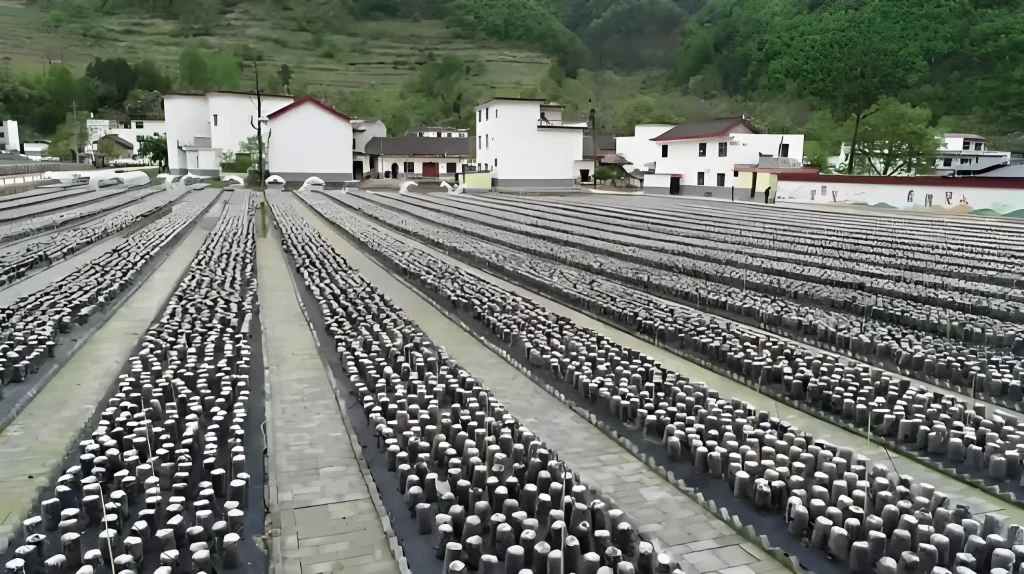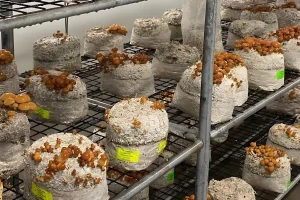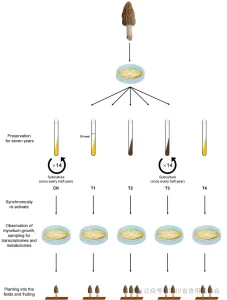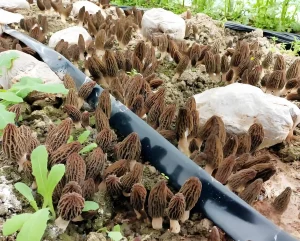The Zhashui fungus, renowned for its fresh flavor, large size, and thick texture, has not only transformed into a “net – famous product” but also emerged as a “golden ear” for local poverty alleviation and income growth. What contributes to the exceptional quality of Zhashui fungus? How has this small – scale fungus developed into a large – scale industry? To uncover the answers, the reporter interviewed Li Bin, the head of the 30th Science and Technology Poverty Alleviation Mission of the Ministry of Science and Technology in Zhashui County and the vice – mayor of Zhashui County, asking him to decode the “innovation formula” of Zhashui fungus.
Small Fungi, Big Industry: Science and Technology Propel Zhashui Fungus to “Surmount Three Hurdles”

Zhashui County, nestled in the heart of the Qinling Mountains in Shangluo City, Shaanxi Province, derives its name from the abundance of oak trees. Oak trees, also referred to as “ear trees,” as the name implies, are the host trees for fungus growth. The fungus growing on these trees is of high quality and considered precious. Local farmers have long had the tradition of cultivating black fungus. However, these black fungi failed to bring prosperity to the local people. As Zhashui County is located in the concentrated and contiguous poverty – stricken areas of the Qinling – Bashan Mountains, poverty was widespread and severe. There were 79 villages in the county with poverty alleviation tasks. In early 2014, the local poverty incidence rate soared to 44.04%.
“Zhashui has ‘nine mountains, half water, and half fen of fields,’ with less than one mu of cultivated land per capita. To escape poverty, we must break free from the mountains and chart an innovative path,” stated Li Bin. Due to the inconvenient transportation in the mountainous region, the cost of cultivating fungus in Zhashui was relatively high. To develop the industry, it was imperative to rely on science and technology to enhance product added – value and promote the “full – industrial – chain” development of poverty alleviation industries.
Since 2017, Zhashui County has designated the fungus industry as the leading industry for poverty alleviation and formulated the “1153” (i.e., 10,000 mu of land, 100 million bags in scale, 5,000 tons of output, and 300 million yuan of output value) development plan. In the initial stages, the fungus industry faced challenges such as a late start, a weak foundation, and a short value chain. It lacked technical support in key core areas and encountered numerous difficulties.
The first hurdle was to select suitable fungus strains. Through the team of Academician Li Yu from Jilin Agricultural University, Zhashui County introduced 5 high – quality black fungus demonstration strains with strong adaptability, high planting yields, and promising promotion prospects. Additionally, 27 local characteristic strains in Zhashui were collected for comparison tests, and rare edible fungi such as jade fungus, golden fungus, morel mushrooms, and bamboo fungus were successfully cultivated. These varieties not only enhanced product value but also made Zhashui fungus well – known.
The second hurdle was to improve industry management. Zhashui County formulated 4 technical regulations, including those for the production of black fungus bags, and completed the first – phase construction of the “Fungus Big Data Center,” the first in the country to integrate production management, farmer guidance, and quality traceability.
“Many people are unaware that our Zhashui fungus ‘grows in the cloud,’” Li Bin explained. To effectively leverage the supporting role of modern information technology in traditional industries, with the assistance of Northwest University and Alibaba Cloud Computing Company, Zhashui County launched the construction of the country’s first “Fungus Big Data Center.” The big data center established modules for the standardized production process management of fungus, an Internet of Things platform, etc. The end – to – end data technology significantly enhanced the comprehensive management level of the fungus industry. The third hurdle was the deep processing of fungus. Zhashui County built a research and development demonstration base for the deep processing of fungus products and successively developed products such as fungus crisps, fungus ultrafine powder, fungus ice cream, and fungus probiotics, effectively increasing the added – value. “Deep processing not only resolves the issue of overstocked primary fungus products but also effectively mitigates the risks associated with single – crop planting, making our fungus industry more resilient and enabling poor households to be firmly ‘embedded’ in the poverty alleviation industrial chain for continuous and stable income growth,” Li Bin said.
Small Fungi Transform into “Golden Ears”: Innovative Organization and Marketing Strategies Shine
The transformation of small fungi into a large – scale industry in Zhashui County is also attributable to innovative organizational models.
Xiao Chao, a villager in Group 3, Xiaotai Village, Xingping Town, Zhashui County, previously attempted to cultivate fungus but achieved meager profits. Since 2017, Xiao Chao has participated in the town’s “borrow – bag – return – fungus” pilot program. “I had no confidence before and lacked the funds to purchase fungus bags. However, the county provided us with fungus bags free of charge for cultivation, so I decided to give it a try. That year, I planted 2.5 mu of field – grown fungus, 20,000 bags. I watered them daily and meticulously managed them according to the technician’s instructions. After more than 4 months, I harvested over 2,000 catties of fungus, with a net profit of over 30,000 yuan!” Since then, Xiao Chao’s enthusiasm for cultivating fungus has grown exponentially. This year, he contracted 3 fungus greenhouses and planted 60,000 bags of fungus, becoming a well – known fungus expert in the local area.
“The so – called ‘borrow – bag – return – fungus’ means that the fungus bags are provided to growers free of charge for cultivation, and we organize the unified purchase of the harvested fungus. After deducting the cost of the fungus bags, the profit is returned to them,” Li Bin elaborated. By exploring innovative mechanisms such as “borrow – shed – return – fungus” and “borrow – bag – return – fungus,” Zhashui County has not only addressed the issue of insufficient start – up funds for industrial development but also established an interest – linkage mechanism with growers, fully stimulating the enthusiasm of the masses. According to statistics, in 2020, Zhashui County planted 55 million bags of fungus and built 500 new greenhouses. More than 2,000 poor households were incorporated through the “borrow – bag – return – fungus, borrow – shed – return – fungus” model.
In terms of marketing, Zhashui fungus has long ventured into e – commerce and is a regular presence on major domestic e – commerce platforms. In 2019, Li Bin participated in the 2019 Harvest Festival Public Welfare Live – streaming Ceremony as a “live – streaming anchor.” In just over ten minutes, 15,000 orders of Zhashui fungus were sold in the live – streaming room, amounting to 552,000 yuan. Over the past few years, Zhashui County has seized the opportunity of consumption – driven poverty alleviation, adhered to the parallel development of “offline docking” and “online promotion,” and made every effort to help Zhashui fungus expand its market, build its brand, and increase its efficiency. This has not only accumulated popularity for Zhashui fungus but also created a favorable market environment for the sustainable and healthy development of the industry. The popularity of Zhashui fungus has also spurred the development of the local tertiary industry. In Xichuan Village, Xialiang Town, Zhashui County, a modern fungus industrial park integrating fungus bag production, demonstration planting, leisure tourism, and product purchase and sales – Zhashui Xichuan Fungus Town – has been constructed, attracting tourists from far and wide to visit and enjoy.
“In my childhood memories, every family in the village struggled to make ends meet. Whoever had some mountain products had to carry them out of the mountains on foot to sell in the county town,” said Hu Dingfeng, a 33 – year – old youth who returned to the village to start a business. “Now the road into the village is wider, and the dirt roads have been paved with cement. The earthen houses with blackened outer walls in the past have all been replaced by buildings. Especially during this Spring Festival, many families had cars parked in front of their houses.”
In the theme park of Xichuan Village Fungus Town, the towering tower is constructed with traditional wooden fungus sticks, and in a small area on the ground, modern fungus bags are arranged. Fungus has become a scenic attraction here!
More:
- 2025: The Year Agriculture Enters the AI Era – A New Wave of Transformation on the Horizon IAgricultural AI Revolution
- Algarikon Zero Project: How a Spanish Firm Transforms Invasive Algae for Edible Mushroom Cultivation
- 🔍 Research Uncovers Key Mechanisms of Morel Strain Degradation
- Spain: Edible Mushrooms Found to Alleviate the “Salty” Dilemma of the Meat Industry
- Yunnan’s Morel Mushroom Industry: Current Status and Prospects


